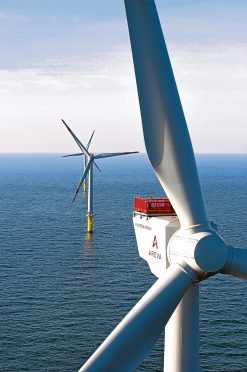Scotland’s offshore wind energy industry workforce has increased by 300%, according to new figures.
A survey by the Office for National Statistics (ONS) showed the number of jobs supported by the sector rose to 2,000 in 2016, compared to the previous year.
The report, which shows onshore wind projects supporting 8,000 positions during the year, has been welcomed by trade body Scottish Renewables.
But, in employment and turnover terms, the numbers show Scotland still lags well behind Denmark, which has led the push towards wind power for some time.
According to the ONS study, turnover from renewable-energy activity in Scotland was almost £5.5billion in 2016, the most recent year for which figures are available.
During the 12 months, Scottish onshore wind projects were responsible for around 46% of the UK’s revenue from the technology.
Scottish Renewables deputy chief executive Jenny Hogan, said: “These new figures clearly show the benefits renewable energy is bringing to Scotland.
“Companies that are developing projects here, as well as supply chain businesses supporting the wider industry, are employing people in skilled jobs and delivering investment from the borders to Shetland.”
She added: “The rise in employment in the offshore wind and renewable heat sectors illustrates the huge boost to jobs and investment that is possible when technologies are given the right backing by government.
“For these benefits to continue and grow, the whole industry needs to see that level of political commitment sustained across the board.”
Figures from the Danish Wind Industry Association show that in 2016 the industry in Denmark employed 32,898 people, which represented a 6% increase on the previous year. The industry’s turnover in the year – its highest since 2009 – was £13.7billion and up 10% on 2015. Scottish Renewables did not comment on the comparison.
The ONS survey also showed the number of people employed in the solar power sector in Scotland plummeted by 75% in 2016, from 2,000 the previous year to 500, following cuts to UK Government support.
Ms Hogan said: “The decline in employment in the solar industry shows clearly the impact of cuts to UK government support for the sector.
“We would expect that future editions of this ONS survey will show declines in other areas caused by similar decisions made at Westminster.”
Recently published energy statistics showed that in 2017 wind turbines delivered the equivalent of 43.6% of Denmark’s total electricity consumption, setting a new record there.
The previous high was achieved in 2015, when wind energy provided 42% of the country’s electricity needs.
